Papers by Jackson Stenner
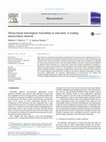
Measurement, 2016
Huge resources are invested in metrology and standards in the natural sciences, engineering, and ... more Huge resources are invested in metrology and standards in the natural sciences, engineering, and across a wide range of commercial technologies. Significant positive returns of human, social, environmental, and economic value on these investments have been sustained for decades. Proven methods for calibrating test and survey instruments in linear units are readily available, as are data-and theory-based methods for equating those instruments to a shared unit. Using these methods, metrological traceability is obtained in a variety of commercially available elementary and secondary English and Spanish language reading education programs in the U.S., Canada, Mexico, and Australia. Given established historical patterns, widespread routine reproduction of predicted text-based and instructional effects expressed in a common language and shared frame of reference may lead to significant developments in theory and practice. Opportunities for systematic implementations of teacher-driven lean thinking and continuous quality improvement methods may be of particular interest and value.
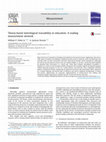
Measurement, 2016
Huge resources are invested in metrology and standards in the natural sciences, engineering, and ... more Huge resources are invested in metrology and standards in the natural sciences, engineering, and across a wide range of commercial technologies. Significant positive returns of human, social, environmental, and economic value on these investments have been sustained for decades. Proven methods for calibrating test and survey instruments in linear units are readily available, as are data-and theory-based methods for equating those instruments to a shared unit. Using these methods, metrological traceability is obtained in a variety of commercially available elementary and secondary English and Spanish language reading education programs in the U.S., Canada, Mexico, and Australia. Given established historical patterns, widespread routine reproduction of predicted text-based and instructional effects expressed in a common language and shared frame of reference may lead to significant developments in theory and practice. Opportunities for systematic implementations of teacher-driven lean thinking and continuous quality improvement methods may be of particular interest and value.
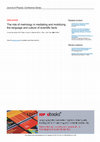
The self-conscious awareness of language and its use is arguably nowhere more intense than in met... more The self-conscious awareness of language and its use is arguably nowhere more intense than in metrology. The careful and deliberate coordination and alignment of shared metrological frames of reference for theory, experiment, and practical application have been characteristics of scientific culture at least since the origins of the SI units in revolutionary France. Though close attention has been focused on the logical and analytical aspects of language use in science, little concern has been shown for understanding how the social and historical aspects of everyday language may have foreshadowed and influenced the development and character of metrological language, especially relative to the inevitably partial knowledge possessed by any given stakeholder participating in the scientific enterprise. Insight in this regard may be helpful in discerning how and if an analogous role for metrology might be created in psychology and the social sciences. It may be that the success of psychology as a science will depend less on taking physics as the relevant model than on attending to the interplay of concepts, models, and social organization that make any culture effective.
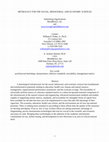
A metrological infrastructure for the social, behavioral, and economic sciences has foundational ... more A metrological infrastructure for the social, behavioral, and economic sciences has foundational and transformative potentials relating to education, health care, human and natural resource management, organizational performance assessment, and the economy at large. The traceability of universally uniform metrics to reference standard metrics is a taken-for-granted essential component of the infrastructure of the natural sciences and engineering. Advanced measurement methods and models capable of supporting similar metrics, standards, and traceability for intangible forms of capital have been available for decades but have yet to be implemented in ways that take full advantage of their capacities. The economy, education, health care reform, and the environment are all now top national priorities. There is nothing more essential to succeeding in these efforts than the quality of the measures we develop and deploy. Even so, few, if any, of these efforts are taking systematic advantage of longstanding, proven measurement technologies that may be crucial to the scientific and economic successes we seek. Bringing these technologies to the attention of the academic and business communities for use, further testing, and development in new directions is an area of critical national need.
Educational Evaluation and Policy Analysis, 1979
... John Hayman Auburn University Nick Rayder Far West Educational Laboratory ... The case-study ... more ... John Hayman Auburn University Nick Rayder Far West Educational Laboratory ... The case-study ap-proach described by Stake (Note 1, p. 96) and the explanatory-observation-study ap-proach described by Cooley (1978) illus-trate promising alternatives in this situa-tion. ...
Educational and Psychological Measurement, 1975
The problem of demonstrating replicability of factor structure across random samples is addressed... more The problem of demonstrating replicability of factor structure across random samples is addressed. Procedures are outlined which combine the use of random subsample replication strategies with the correlations between factor score estimates across replicate pairs to generate a coefficient of replicability and confidence intervals associated with the coefficient. Data from the national norming sample of the Self Observation Scales are used in the illustrative example.
Educational and Psychological Measurement, 1977
The problem of demonstrating the invariance of factor structures across criterion groups is addre... more The problem of demonstrating the invariance of factor structures across criterion groups is addressed. Procedures are outlined which combine the replication of factor structures across four sex-race groups with the use of the coefficient of invariance to demonstrate the level of invariance associated with the factors identified in a self concept measure (the Self Observation Scales, Intermediate Form A). Implications for hypothesis testing are discussed.
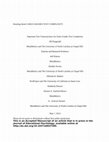
Journal of Educational Psychology, 2014
The Common Core set a standard for all children to read increasingly complex texts throughout sch... more The Common Core set a standard for all children to read increasingly complex texts throughout schooling. The purpose of the present study was to explore text characteristics specifically in relation to early-grades text complexity. Three-hundred-fifty primary-grades texts were selected and digitized. Twenty-two text characteristics were identified at four linguistic levels, and multiple computerized operationalizations were created for each of the 22 text characteristics. A researcher-devised text-complexity outcome measure was based on: teacher judgment of text complexity in the 350 texts; and text complexity as gauged from student responses using a maze task for a subset of the 350 texts. Analyses were conducted using a logical analytical progression typically used in machine-learning research. Random forest regression was the primary statistical modeling technique. Nine text characteristics were most important for early-grades text complexity including word structure (decoding demand and number of syllables in words), word meaning (age of acquisition, abstractness, and word rareness), and sentence and discourse-level characteristics (intersentential complexity, phrase diversity, text density/information load, and non-compressibility). Notably, interplay among text characteristics was important to explanation of text complexity, particularly for subsets of texts.
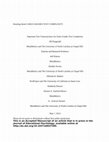
Journal of Educational Psychology, 2014
The Common Core set a standard for all children to read increasingly complex texts throughout sch... more The Common Core set a standard for all children to read increasingly complex texts throughout schooling. The purpose of the present study was to explore text characteristics specifically in relation to early-grades text complexity. Three-hundred-fifty primary-grades texts were selected and digitized. Twenty-two text characteristics were identified at four linguistic levels, and multiple computerized operationalizations were created for each of the 22 text characteristics. A researcher-devised text-complexity outcome measure was based on: teacher judgment of text complexity in the 350 texts; and text complexity as gauged from student responses using a maze task for a subset of the 350 texts. Analyses were conducted using a logical analytical progression typically used in machine-learning research. Random forest regression was the primary statistical modeling technique. Nine text characteristics were most important for early-grades text complexity including word structure (decoding demand and number of syllables in words), word meaning (age of acquisition, abstractness, and word rareness), and sentence and discourse-level characteristics (intersentential complexity, phrase diversity, text density/information load, and non-compressibility). Notably, interplay among text characteristics was important to explanation of text complexity, particularly for subsets of texts.
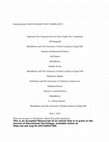
Journal of Educational Psychology, 2014
The Common Core set a standard for all children to read increasingly complex texts throughout sch... more The Common Core set a standard for all children to read increasingly complex texts throughout schooling. The purpose of the present study was to explore text characteristics specifically in relation to early-grades text complexity. Three-hundred-fifty primary-grades texts were selected and digitized. Twenty-two text characteristics were identified at four linguistic levels, and multiple computerized operationalizations were created for each of the 22 text characteristics. A researcher-devised text-complexity outcome measure was based on: teacher judgment of text complexity in the 350 texts; and text complexity as gauged from student responses using a maze task for a subset of the 350 texts. Analyses were conducted using a logical analytical progression typically used in machine-learning research. Random forest regression was the primary statistical modeling technique. Nine text characteristics were most important for early-grades text complexity including word structure (decoding demand and number of syllables in words), word meaning (age of acquisition, abstractness, and word rareness), and sentence and discourse-level characteristics (intersentential complexity, phrase diversity, text density/information load, and non-compressibility). Notably, interplay among text characteristics was important to explanation of text complexity, particularly for subsets of texts.
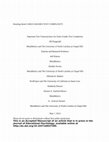
Journal of Educational Psychology, 2014
The Common Core set a standard for all children to read increasingly complex texts throughout sch... more The Common Core set a standard for all children to read increasingly complex texts throughout schooling. The purpose of the present study was to explore text characteristics specifically in relation to early-grades text complexity. Three-hundred-fifty primary-grades texts were selected and digitized. Twenty-two text characteristics were identified at four linguistic levels, and multiple computerized operationalizations were created for each of the 22 text characteristics. A researcher-devised text-complexity outcome measure was based on: teacher judgment of text complexity in the 350 texts; and text complexity as gauged from student responses using a maze task for a subset of the 350 texts. Analyses were conducted using a logical analytical progression typically used in machine-learning research. Random forest regression was the primary statistical modeling technique. Nine text characteristics were most important for early-grades text complexity including word structure (decoding demand and number of syllables in words), word meaning (age of acquisition, abstractness, and word rareness), and sentence and discourse-level characteristics (intersentential complexity, phrase diversity, text density/information load, and non-compressibility). Notably, interplay among text characteristics was important to explanation of text complexity, particularly for subsets of texts.
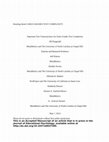
Journal of Educational Psychology, 2014
The Common Core set a standard for all children to read increasingly complex texts throughout sch... more The Common Core set a standard for all children to read increasingly complex texts throughout schooling. The purpose of the present study was to explore text characteristics specifically in relation to early-grades text complexity. Three-hundred-fifty primary-grades texts were selected and digitized. Twenty-two text characteristics were identified at four linguistic levels, and multiple computerized operationalizations were created for each of the 22 text characteristics. A researcher-devised text-complexity outcome measure was based on: teacher judgment of text complexity in the 350 texts; and text complexity as gauged from student responses using a maze task for a subset of the 350 texts. Analyses were conducted using a logical analytical progression typically used in machine-learning research. Random forest regression was the primary statistical modeling technique. Nine text characteristics were most important for early-grades text complexity including word structure (decoding demand and number of syllables in words), word meaning (age of acquisition, abstractness, and word rareness), and sentence and discourse-level characteristics (intersentential complexity, phrase diversity, text density/information load, and non-compressibility). Notably, interplay among text characteristics was important to explanation of text complexity, particularly for subsets of texts.

Journal of Educational Psychology, 2014
The Common Core set a standard for all children to read increasingly complex texts throughout sch... more The Common Core set a standard for all children to read increasingly complex texts throughout schooling. The purpose of the present study was to explore text characteristics specifically in relation to early-grades text complexity. Three-hundred-fifty primary-grades texts were selected and digitized. Twenty-two text characteristics were identified at four linguistic levels, and multiple computerized operationalizations were created for each of the 22 text characteristics. A researcher-devised text-complexity outcome measure was based on: teacher judgment of text complexity in the 350 texts; and text complexity as gauged from student responses using a maze task for a subset of the 350 texts. Analyses were conducted using a logical analytical progression typically used in machine-learning research. Random forest regression was the primary statistical modeling technique. Nine text characteristics were most important for early-grades text complexity including word structure (decoding demand and number of syllables in words), word meaning (age of acquisition, abstractness, and word rareness), and sentence and discourse-level characteristics (intersentential complexity, phrase diversity, text density/information load, and non-compressibility). Notably, interplay among text characteristics was important to explanation of text complexity, particularly for subsets of texts.
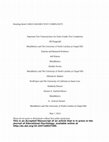
Journal of Educational Psychology, 2014
The Common Core set a standard for all children to read increasingly complex texts throughout sch... more The Common Core set a standard for all children to read increasingly complex texts throughout schooling. The purpose of the present study was to explore text characteristics specifically in relation to early-grades text complexity. Three-hundred-fifty primary-grades texts were selected and digitized. Twenty-two text characteristics were identified at four linguistic levels, and multiple computerized operationalizations were created for each of the 22 text characteristics. A researcher-devised text-complexity outcome measure was based on: teacher judgment of text complexity in the 350 texts; and text complexity as gauged from student responses using a maze task for a subset of the 350 texts. Analyses were conducted using a logical analytical progression typically used in machine-learning research. Random forest regression was the primary statistical modeling technique. Nine text characteristics were most important for early-grades text complexity including word structure (decoding demand and number of syllables in words), word meaning (age of acquisition, abstractness, and word rareness), and sentence and discourse-level characteristics (intersentential complexity, phrase diversity, text density/information load, and non-compressibility). Notably, interplay among text characteristics was important to explanation of text complexity, particularly for subsets of texts.
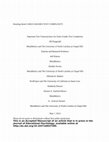
Journal of Educational Psychology, 2014
The Common Core set a standard for all children to read increasingly complex texts throughout sch... more The Common Core set a standard for all children to read increasingly complex texts throughout schooling. The purpose of the present study was to explore text characteristics specifically in relation to early-grades text complexity. Three-hundred-fifty primary-grades texts were selected and digitized. Twenty-two text characteristics were identified at four linguistic levels, and multiple computerized operationalizations were created for each of the 22 text characteristics. A researcher-devised text-complexity outcome measure was based on: teacher judgment of text complexity in the 350 texts; and text complexity as gauged from student responses using a maze task for a subset of the 350 texts. Analyses were conducted using a logical analytical progression typically used in machine-learning research. Random forest regression was the primary statistical modeling technique. Nine text characteristics were most important for early-grades text complexity including word structure (decoding demand and number of syllables in words), word meaning (age of acquisition, abstractness, and word rareness), and sentence and discourse-level characteristics (intersentential complexity, phrase diversity, text density/information load, and non-compressibility). Notably, interplay among text characteristics was important to explanation of text complexity, particularly for subsets of texts.
Popular Measurement, 1999

Journal of Applied Measurement, 2010
The use of Rasch-derived latent trait measurement of outcomes for persons with chronic disease an... more The use of Rasch-derived latent trait measurement of outcomes for persons with chronic disease and disablement evolved from other fields, particularly education. Person-metrics is the measurement of how much chronic disease and disablement affects an individual's daily activities physically, cognitively, and through vocational and social role participation. The ability of the Rasch model to assume that the probability of a given person/item interaction is governed by the difficulty of the item and the ability of the person is invaluable to disability measurement. The difference between raw scores and true measures is illustrated by an example of a patient whose physical difficulty is rated on rising from a wheelchair and walking 100m (known to be more difficult), and then walking an additional 200m. Though number ratings of 0-1-2 are assigned to these tasks, they are not equidistant, and only a true measure shows the actual levels of physical difficulty.
Http Dx Doi Org 10 1080 19388071 2013 812165, Aug 8, 2013
This is Volume I of the five volumes comprising the common Career Education Evaluation Final Repo... more This is Volume I of the five volumes comprising the common Career Education Evaluation Final Report. The volumes include the following:
Http Dx Doi Org 10 1080 02702711 2013 843063, Nov 21, 2014






Uploads
Papers by Jackson Stenner